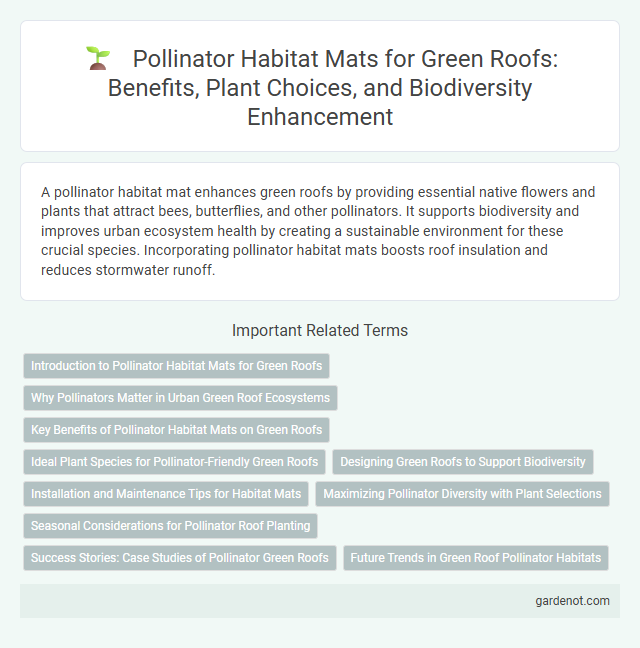A pollinator habitat mat enhances green roofs by providing essential native flowers and plants that attract bees, butterflies, and other pollinators. It supports biodiversity and improves urban ecosystem health by creating a sustainable environment for these crucial species. Incorporating pollinator habitat mats boosts roof insulation and reduces stormwater runoff.
Introduction to Pollinator Habitat Mats for Green Roofs
Pollinator habitat mats for green roofs provide essential support for native bees, butterflies, and other pollinators by offering flowering plants that thrive in urban environments. These mats enhance biodiversity and improve rooftop ecosystem health by creating continuous forage and nesting sites on otherwise barren roof surfaces. Incorporating pollinator habitat mats contributes to sustainable green roof design, promoting ecological balance and aiding in pollination services critical for urban greenery.
Why Pollinators Matter in Urban Green Roof Ecosystems
Pollinator habitat mats on green roofs support crucial species like bees and butterflies, which enhance urban biodiversity by facilitating cross-pollination of plants. These mats improve the productivity and resilience of urban green roof ecosystems by promoting healthy plant reproduction and genetic diversity. Establishing pollinator-friendly environments in cities mitigates habitat loss and supports food webs essential for ecological balance.
Key Benefits of Pollinator Habitat Mats on Green Roofs
Pollinator habitat mats on green roofs enhance urban biodiversity by providing essential nectar and pollen sources for bees, butterflies, and other pollinators. These mats improve green roof ecosystem services, including increased plant diversity, natural pest control, and improved pollination rates, which support overall plant health. Integrating pollinator habitat mats also contributes to urban heat island mitigation and stormwater management by promoting diverse vegetation cover.
Ideal Plant Species for Pollinator-Friendly Green Roofs
Ideal plant species for pollinator-friendly green roofs include native wildflowers such as Echinacea purpurea, Asclepias tuberosa, and Solidago canadensis, which provide nectar and pollen for bees, butterflies, and other pollinators. Sedum species like Sedum acre and Sedum album offer drought resistance and extended bloom periods, creating continuous food sources. Incorporating these plants into a pollinator habitat mat enhances biodiversity and supports ecosystem resilience on urban green roofs.
Designing Green Roofs to Support Biodiversity
Pollinator habitat mats are specially designed to enhance biodiversity on green roofs by providing native flowering plants that attract bees, butterflies, and other pollinators essential for ecosystem health. Incorporating diverse plant species with varying bloom times ensures continuous food sources, fostering a resilient urban habitat. These mats optimize green roof functions by improving pollination, supporting local wildlife, and contributing to sustainable urban environments.
Installation and Maintenance Tips for Habitat Mats
Pollinator habitat mats require careful installation by placing them on well-prepared, weed-free soil with adequate sunlight exposure to support native flowering plants. Regular maintenance includes watering during dry periods, monitoring for invasive species, and periodic trimming to promote healthy growth and continuous bloom. Using organic mulch around the mats can enhance moisture retention and provide additional protection for emerging pollinator habitats.
Maximizing Pollinator Diversity with Plant Selections
Selecting a diverse mix of native flowering plants on pollinator habitat mats enhances habitat quality and supports a wide range of bee, butterfly, and other pollinator species essential for ecosystem health. Incorporating species with staggered bloom periods ensures continuous nectar and pollen sources throughout the growing season, maximizing pollinator diversity and activity on green roofs. Tailoring plant selections to local climate conditions and soil properties further improves establishment success and long-term sustainability of pollinator habitats.
Seasonal Considerations for Pollinator Roof Planting
Pollinator habitat mats for green roofs require careful seasonal planning to ensure continuous bloom cycles that support native pollinators throughout the year. Selecting a mix of early, mid, and late-season flowering plants helps maintain nectar and pollen availability across spring, summer, and fall. Incorporating native species adapted to local climate conditions enhances survival rates and promotes biodiversity on pollinator roof installations.
Success Stories: Case Studies of Pollinator Green Roofs
Pollinator habitat mats have transformed urban green roofs into vital ecosystems, supporting native bees, butterflies, and other pollinators. Case studies from cities like Chicago and Berlin demonstrate increased biodiversity and improved pollination rates when these specialized mats, rich in native flowering plants, are incorporated. Metrics reveal a 40% rise in pollinator visits and enhanced plant health, showcasing successful integration of ecological function with urban infrastructure.
Future Trends in Green Roof Pollinator Habitats
Pollinator habitat mats on green roofs are evolving with enhanced seed mixes tailored to local native species, promoting biodiversity and supporting declining pollinator populations. Advances in lightweight, biodegradable materials improve mat durability and establishment, reducing environmental impact and maintenance needs. Integration of smart irrigation systems and IoT sensing technology ensures optimal moisture levels, fostering resilient habitats responsive to climate change challenges.
Pollinator habitat mat Infographic

 gardenot.com
gardenot.com